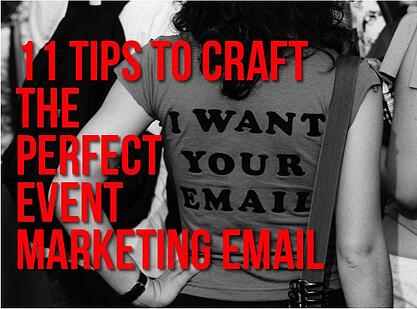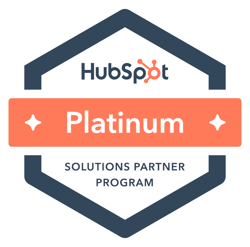Email marketing is still the majority of event marketers’ go-to tool for promoting their events, and with good reason. When done right the results can be astounding, but in the hands of an old school marketer , email can be an overused (and even harmful) tool.
 We’ve observed that the pattern is pretty much always the same: 12 weeks out from the event, marketers start blasting. They don’t segment their lists, meaning they end up sending a blanket email which attempts to provide something for everyone and as a result is pretty lengthy and vague, and try to cram in as much information as possible. The cycle is then repeated until the event takes place, causing recipients to disengage and in some cases even unsubscribe completely.
We’ve observed that the pattern is pretty much always the same: 12 weeks out from the event, marketers start blasting. They don’t segment their lists, meaning they end up sending a blanket email which attempts to provide something for everyone and as a result is pretty lengthy and vague, and try to cram in as much information as possible. The cycle is then repeated until the event takes place, causing recipients to disengage and in some cases even unsubscribe completely.
Our foolproof strategy is naturally a little different from this approach. Concise, relevant and valuable content is key to successful event email marketing, and here are our top tactics for engaging with your prospective delegates:
1. Keep it succinct and to the point
You don’t need to tell your prospects every piece of information you have about your event in one single communication. Hold something back and focus on one key announcement per email. It will give you the chance to go into detail on your speakers, panel, agenda, breakouts – and anything else you want to shout about. Plus that is why you have the whole thing on your website, otherwise you will be repeating the same thing.
2. Limit yourself to one or two calls-to-action (CTA)
If you have links to download the agenda, visit the speaker page, register to attend, view the venue location etc - it may be a little overwhelming. Think about the action that you’d most like your prospects to take, and prioritise that.
3. Segment your database by buyer persona and tailor the email accordingly
Segmentation is absolutely crucial to event email marketing success. It means the chances of your email being relevant are hugely increased and you’re more likely to strike a chord with your audience. After you’ve segmented by buyer persona, tailor your subject line and elements of the email body to that specific persona.
4. Provide something useful
Rather than simply listing facts about your event (date, time, agenda, speakers, venue) provide some kind of relevant insight in the body of your email; a recent industry development, intriguing statistic or reference to a hot topic for your audience segment. This must then in turn relate back to your event. If you know your event sector it won’t be difficult to find something to talk about – you should be able to draw upon existing content you have, and your expertise.
5. Link to your blog or latest news updates
In your event communications, it is still a good idea to link to your blog, ideally with a post that is connected to your event. This way, even if your event isn’t right for the recipient there is still potential for them to find your email useful. You should create event specific blogs that you can link to, as well as posts relating to the general theme you’re addressing. If you don't have link to a relevant news update - and if you don't have this either create an area for this on your site now!
6. Move away from event marketing jargon
It’s important to stand out when marketing your conference, particularly in your emails. A sure-fire way of doing this is avoid using standard event marketing terms. ‘Last chance’, ‘places fill up fast’, ‘don’t miss’, ‘last tickets available’ are all tired, boring ways to encourage registrations. You don’t need to reinvent the wheel, but try being a little more creative with your copy and not relying so much on these overused words.
7. Don’t forget about the plain text version
The plain text version of your email is important too, and it won’t take you very long to make sure it reads well and looks as pleasing as possible. Tidy up your links, and don’t repeat them if you can help it. If you have used images, make sure the alt text and reference to the images is deleted.
8. Subject lines should be interesting, specific and explanatory
Your subject line will signal whether your email is relevant, and more importantly, of interest to the recipient – and taking the time to craft a good subject header well is a job worth doing. If you’ve addressed our earlier point on segmentation this should be a breeze. Use a relevant keyword, and find an angle that will intrigue your audience, or resonate . Using an open ended question is an effective method, and you can then go on to answer, or explore the question within the enclosed email. And remember to stick to 50 characters or fewer or just 34 for mobile users.
9. Address a pain point of the segment you’re targeting, and how your event will help them to tackle it
Now you know exactly who you’re writing for, think about how you can broach a particular pain point, or concern of that buyer persona - you could do this in your subject line for example. Essentially you need to demonstrate how your event will help to solve that particular issue.
10. Use bullets and short paragraphs so it’s easy to scan
Emails are often read very quickly, if at all, and it’s increasingly likely that your email will be opened on a mobile device. This means your content needs to be easy to skim read, as it’s unlikely to be given a huge amount of time. Stick to short paragraphs and bullet points so your readers can easily locate the bits that are most relevant to them.
11. Use personalisation
B2B email marketers often debate the merits of personalisation, but on the whole it has been shown to yield positive results. Adding that personal touch, combined with the use of buyer persona tailored copy and content, will signal that you’re as interested in your audience as you would like them to be in your event.
How does your current strategy differ from the above?
The end result of these steps will help you to get noticed for all the right reasons. This approach is essentially about stripping back all of those event email marketing clichés and communicating with your audience in a way that strives to add value, provide clarity and leave your recipients with a positive feeling towards your organisation.
And don't stay static - keep testing and reviewing your analytics, and putting your findings into practise. If you want to turn what you’ve learned into action, or find out what the perfect email for your audience actually looks like, I would be happy to cast an eye on your current email tactics and give you some feedback.
Image credit: Kevin Fitz







Do you have any comments?